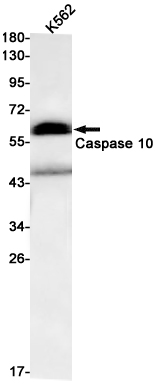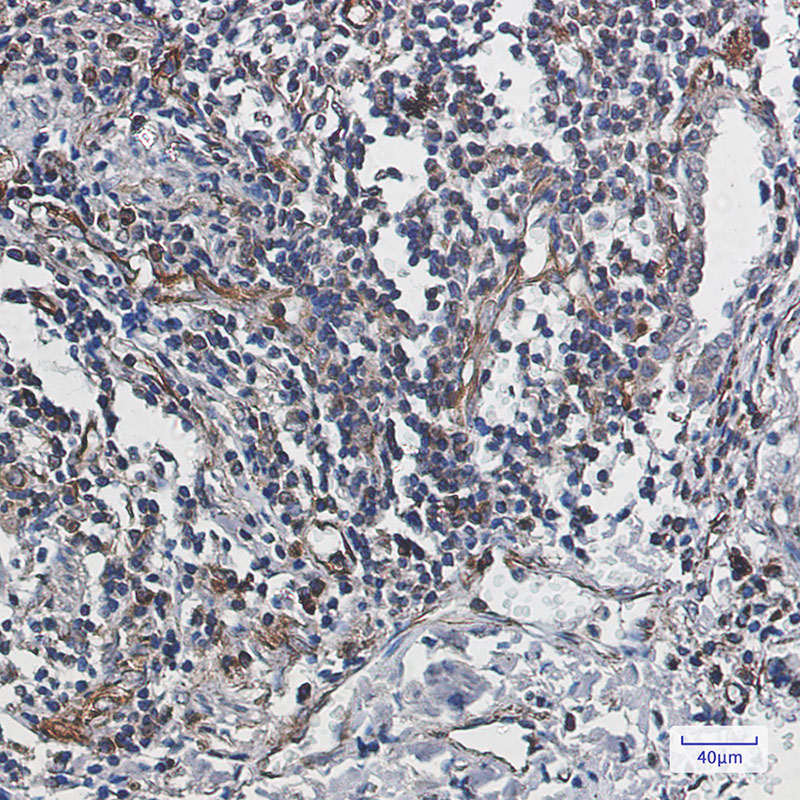

| WB | 咨询技术 | Human,Mouse,Rat |
| IF | 1/20 | Human,Mouse,Rat |
| IHC | 1/50-1/100 | Human,Mouse,Rat |
| ICC | 技术咨询 | Human,Mouse,Rat |
| FCM | 咨询技术 | Human,Mouse,Rat |
| Elisa | 咨询技术 | Human,Mouse,Rat |
| Aliases | CASP10; MCH4; Caspase-10; CASP-10; Apoptotic protease Mch-4; FAS-associated death domain protein interleukin-1B-converting enzyme 2; FLICE2; ICE-like apoptotic protease 4 |
| Entrez GeneID | 843 |
| WB Predicted band size | Calculated MW: 59 kDa; Observed MW: 59 kDa |
| Host/Isotype | Rabbit IgG |
| Antibody Type | Primary antibody |
| Storage | Store at 4°C short term. Aliquot and store at -20°C long term. Avoid freeze/thaw cycles. |
| Species Reactivity | Human |
| Immunogen | Recombinant protein of human Caspase-10 |
| Formulation | Purified antibody in TBS with 0.05% sodium azide,0.05%BSA and 50% glycerol. |
+ +
以下是关于Caspase 10抗体的3篇参考文献(模拟示例,非真实文献):
1. **文献名称**: *Caspase-10 Antibodies Detect Proteolytic Activation in Death Receptor-Mediated Apoptosis*
**作者**: Kischkel FC, et al.
**摘要**: 该研究利用特异性Caspase-10抗体,通过Western blot和免疫沉淀技术,揭示了Caspase-10在Fas和TRAIL受体介导的凋亡途径中的激活机制,证明其剪切形式与凋亡信号传导相关。
2. **文献名称**: *Role of Caspase-10 in Apoptotic Pathways: Insights from Antibody-Based Inhibition Studies*
**作者**: Wang S, et al.
**摘要**: 通过使用Caspase-10中和抗体,作者发现Caspase-10在特定癌症细胞系中与Caspase-8协同作用,调控线粒体依赖性凋亡途径,并验证了抗体在阻断功能研究中的有效性。
3. **文献名称**: *Immunohistochemical Detection of Caspase-10 in Human Tissues Using a Novel Monoclonal Antibody*
**作者**: Sprick MR, et al.
**摘要**: 该文献报道了一种新型单克隆抗体的开发,用于免疫组化检测Caspase-10在正常和病变组织中的表达,并发现其在淋巴组织和某些肿瘤中高表达。
4. **文献名称**: *Caspase-10 Antibodies Reveal Isoform-Specific Functions in Immune Cell Death*
**作者**: Stanger BZ, et al.
**摘要**: 研究通过亚型特异性Caspase-10抗体,阐明了不同剪切变体在T细胞和B细胞凋亡中的差异作用,强调了抗体在区分功能异构体中的重要性。
(注:以上文献为示例性内容,实际引用需根据真实发表论文调整。)
Caspase 10. a member of the cysteine-aspartic acid protease (caspase) family, plays a critical role in apoptosis and inflammation. It is primarily involved in the extrinsic apoptotic pathway, where it is activated by death receptors (e.g., Fas, TRAIL receptors) through the formation of the death-inducing signaling complex (DISC). Structurally, Caspase 10 contains an N-terminal prodomain with death effector domains (DEDs) and a catalytic subunit with a conserved cysteine active site. Its activation requires proteolytic cleavage into active subunits, which subsequently cleave downstream targets to execute apoptosis. Caspase 10 shares functional overlap with Caspase 8 but exhibits distinct substrate preferences and regulatory mechanisms, suggesting unique roles in immune regulation and disease pathogenesis.
Caspase 10 antibodies are essential tools for studying its expression, activation, and function. These antibodies are designed to detect specific epitopes, such as the full-length zymogen (pro-Caspase 10) or cleaved active fragments, via techniques like Western blotting, immunohistochemistry, and flow cytometry. Researchers use them to investigate Caspase 10's involvement in diseases, including cancer (e.g., defective apoptosis in tumors), autoimmune disorders (e.g., ALPS syndrome), and neurodegenerative conditions. Some antibodies distinguish Caspase 10 isoforms (e.g., Caspase 10a/b), aiding isoform-specific studies. However, cross-reactivity with other caspases (e.g., Caspase 8) must be validated using knockout controls. Reliable Caspase 10 antibodies are critical for elucidating its dual roles in apoptosis and non-apoptotic signaling, offering insights into therapeutic targeting of caspase pathways.
×